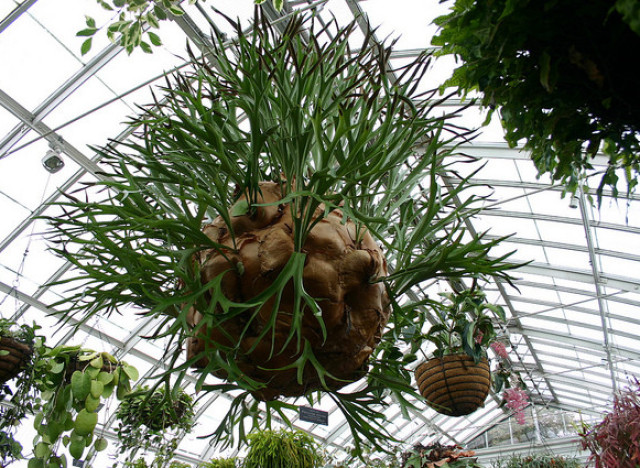
Flickr photo by Ryan Somma
In the fern world the staghorn separates itself as being the odd one. Along with their unusual shape they also have an uncommon habitat. Native to tropical and temperate areas this fern does not grow rooted in the ground but instead they grow off of others like trees. They are not parasitic, not causing any harm to the tree, but instead create a strange visual harmony with its host. Belonging to the genus Platycerium (greek for broad-horn) the most common staghorn fern that you might find at your local garden center is Platycerium bifurcatum.
Adult plants have two types of fronds--basal and fertile. The basal fronds look like a suction cup or kidney that protect the staghorn fern's root system from harm. The basal fronds will naturally turn brown with age but do not remove them. The fertile fronds can be compared to antlers in shape, jetting out in various directions, almost frenzied looking. The fronds are called 'fertile' because they bear spores in clusters on the underside of the leaves. They have a fuzzy white coating on the fronds that many people mistake as dust but it is actually hair projecting from the leaf surface. Do not try to remove this fuzz, the coating is actually protecting the plant from getting sunburn and is thought to inhibit moisture loss from the leaf surface.
Staghorn ferns do love humidity so keep your mister handy. They enjoy bright light and can handle some direct sun if kept moist. Although they can be quite drought tolerant water them frequently, especially during the warm growing season, and let them go slightly dry in between watering. Feed during the growing season with a diluted all purpose fertilizer. They can be potted in soil especially when they are young but make sure that you use a well draining potting mix. As they get older they prefer to be mounted, recreating their natural habit.
Since they do not need soil they are great to show off in unusual ways. Try potting them in a hanging basket with a fibrous liner such as spagnum moss--the staghorn will eventually grow through the lining. You can also attach them to plaques or pieces of wood to display them as pieces of art on your wall. Affix four screws in to your selected board a couple inches bigger than the plants basal plate, mound moistened moss in the center of the screws then with the dirt removed from the staghorn, place your plant in the center of the moss wrapping its root system within the moss mound. After you have the fern where you want it, use fishing line to secure it in to place by utilizing the screws as anchors and criss-cross the wire over the new construction. Once they are mounted try not to disturb them unless you need to take a cutting. Take it one step further by literally framing your mounted staghorn with that incredible frame that you just couldn't figure how to re-purpose. The staghorn wouldn't mind, it screams for attention.